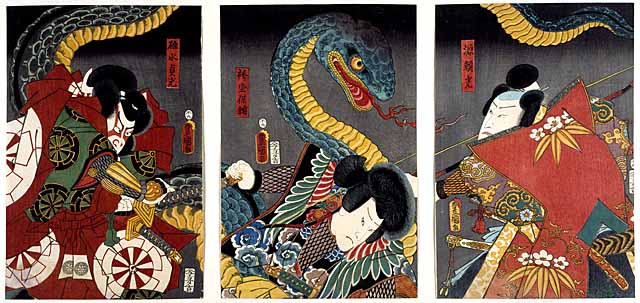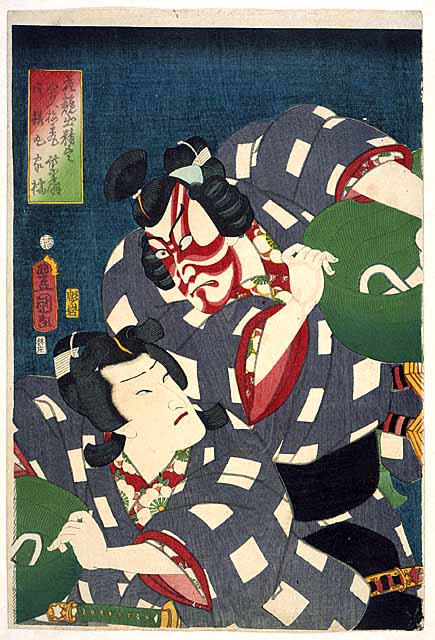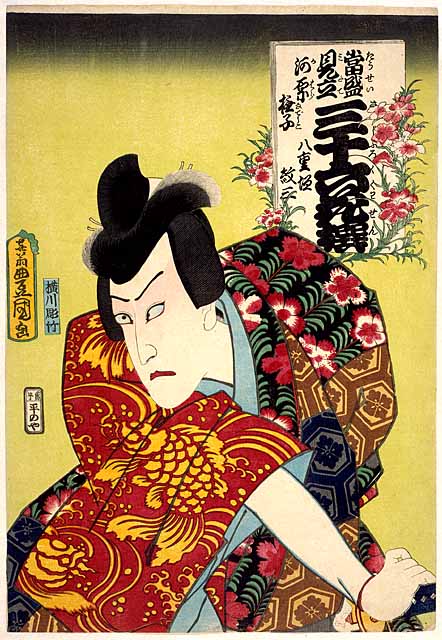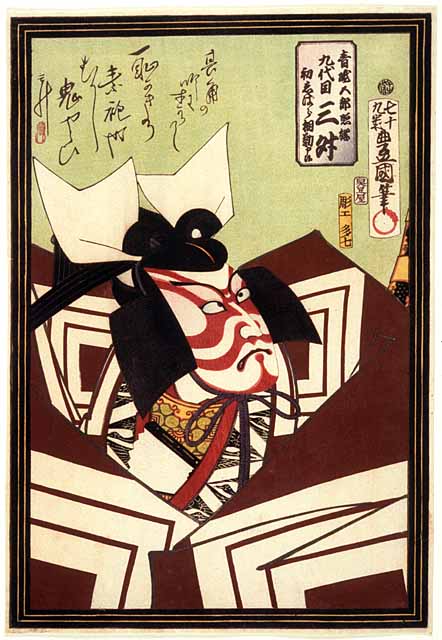
Nakamura Fukusuke I as Minamoto no Raiko(right), Ichikawa Ichizo III as Hakamadare Yasusuke (centre) and Kawarazaki Gonjuro I as Usui Sadamitsu (left) 1858/12
Kunisada 51
Given by the Friends of the Fitzwilliam with the aid of the MGC Purchase Grant Fund and the National Art Collections Fund.
A triptych of a battle with a giant snake featuring Minamoto no Yorimitsu, or Raiko (944-1104), who according to legend, was supposed to have rid Japan of many perilous demons.
Collections Record: P.74-1999

Kawarazaki Shisen (Kawarazaki Gonjuro I as Umeo-maru and Ichimura Kakitsu (Ichimura Uzaemon XIII) as Sakura-maru
Kunisada 64
Kawarazaki Shisen (Kawarazaki Gonjuro I) as Umeo-maru and Ichimura Kakitsu (Ichimura Uzaemon XIII) as Sakura-maru in Sugawara denju tenarai kagami (Sugawara and the secrets of calligraphy) performed at the Ichimura theatre from 17/10/1861
Given by the Friends of the Fitzwilliam with the aid of the MGC Purchase Grant Fund and the National Art Collections Fund.
From the set entitled ‘Series Comparing the Diligence of Young Flowers’ (Hana-kurabe shussei-zukushi), published 11/1861. Kunisada designed several prints in connection with this performance, three of which are included in this exhibition in this case.
This print depicts two of the triplets in the scene called Kuruma Biki (Pulling the Carriage Apart) in which they confront their triplet brother Matsuo-maru who serves their enemy Shihei.
They each wear a thick padded dotera kimono with a pattern of large purple and white squares (soshigoshi). They hold the green wicker hats (amigasa) that they have just removed, revealing their faces. Sakuramaru is the more elegant figure with subtle eye make-up known as mukimi (‘trough-shell shadows’) and divided forelock wig called mae jasen (‘front-facing tea whisk’); his more gentle role is traditionally played in a slightly effeminate manner (wakashugata).
In contrast Umeo-maru is one of the prime examples of the aragoto (‘rough-stuff’) style of acting, with appropriately fierce red make-up with extra shadow lines (nihon suji guma), and extravagant wig with high pom-pom and spoke-like projections on either side, known as the kuruma bin (carriage sidelocks). For this scene he wore muscular body ‘make-up’, visible on his hands and arms, which was actually dyed onto white silk skin-garments. Aragoto roles were particularly associated with the Danjuro lineage of actors.
Collections Record: P.86-1999

Mitate Sangoku-shi bairin ni asondeshuen o tanoshimu zu (Comparison with ‘Romance of the Three Kingdoms’: Picture of enjoying a banquet in the plum orchard)
Kunisada 53
01/1859
Given by the Friends of the Fitzwilliam with the aid of the MGC Purchase Grant Fund and the National Art Collections Fund.
A triptych published by Ebisuya Shoshichi of the Kabuki actors Nakamura Fukusuke I (right), Ichikawa Ichizo III (centre) and Kawarazaki Gonjuro I (left), enjoying a picnic in a plum orchard. The print alludes to the famous scene in which the three heroes of the Chinese kingdom of Shu (Guan Yu, Liu Bei and Zhang Fei) exchanged oaths of brotherhood while drinking wine in a peach orchard. Their tale was best known through the Chinese novel Romance of the three kingdoms, which was introduced into Japan in the early Edo period and remains popular today. The orchard scene often appeared in paintings and prints, such as the surimono by Kunisada.
Collections Record: P.76-1999

Kawarazaki Gonjuro I (Danjuro IX) backstage applying make-up for the role of Umeo-maru in Sugawara denju tenarai kagami (Sugawara and the secrets of calligraphy) performed at the Ichimura theatre from 17/10/1861
Given by the Friends of the Fitzwilliam with the aid of the MGC Purchase Grant Fund and the National Art Collections Fund
Published in 12/1861. Kunisada designed several prints in connection with this performance, three of which are displayed in this case. Umeo-maru is one of the prime examples of the aragoto or ‘rough-stuff’ style of kabuki role, with appropriately fierce red make-up (nipponsujigama) applied on a white base, and an extravagant wig (seen on the wig-stand) with high pom-pom and spoke-like projections on either side, known as the kuruma bin (carriage sidelocks). Gonjuro I can be seen as Umeo-maru in another print in this exhibition.
Collections Record: P.87-1999

Kawarazaki Gonjuro Yaegaki Monza kawara nadeshiko (Kawarazaki Gonjuro I as Yaegaki Monza: Wild Pink)
1862
Given by the Friends of the Fitzwilliam with the aid of the MGC Purchase Grant Fund and the National Art Collections Fund
From the series Tosei mitate sanju-rokkasen (Comparison of roles with the thirty-six flowers at their zenith). The grouping of thirty-six, which was common in prints (flowers, views of Fuji, etc.), alludes to the grouping of thirty-six ‘immortal poets’ first selected and listed by the 11th-century poet and critic, Fujiwara no Kinto.
The use of acid background colours in this set (using newly available pigments) is particularly striking.
Collections Record: P.89-1999

Ichikawa Sansho (Danjuro IX) as Aoito no Goro Terutsuna in Shibaraku! (‘Stop right there!’)
12/1864
Given by the Friends of the Fitzwilliam with the aid of the MGC Purchase Grant Fund and the National Art Collections Fund.
Published shortly before Kunisada’s death, this print is signed Shichijukyu-sai Toyokuni hitsu (‘from the brush of the seventy-nine-year-old Toyokuni’). A poem in the actor’s own hand is printed at top left, signed with his poetry name, Sansho.
Kunisada had depicted successive generations of the Ichikawa lineage of actors in the role of Gongoro in Shibaraku!, which was one of the great examples of the ‘rough-stuff’ style (aragoto) for which the Ichikawa line of actors was famous. All of Kunisada’s prints depict the moment of the character’s entrance, one of the highpoints of all kabuki. Narita Goro is on the point of executing the innocent Yoshitsuna and his fianc�e, when the voice of Gongoro comes from the rear of the theatre shouting ‘Shibaraku! Shibaraku!’ (‘Stop right there!’). The hero then strides onto the hanamichi passageway leading through the audience, wearing the most extravagant costume: a voluminous suo (‘plain sliding-door’) robe, with the Ichikawa crest (mon) of triple-rice-measures (mimasu) adorning square sleeves so wide that they have to be supported with splints.
Collections Record: P.91-1999



